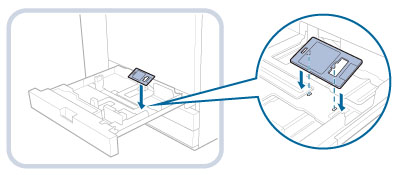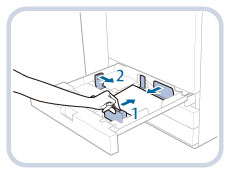Loading Envelopes
This section explains how to load envelopes into a paper drawer.
You can load envelopes into the following paper sources.
Paper drawers of the main unit
Stack Bypass-B1
POD Deck Lite-B1
Multi-drawer Paper Deck-B1
|
IMPORTANT
|
|
Do not load the following types of envelopes inside the envelope cassette. Doing so may cause paper jams, dirty prints, or make the inside of the machine dirty.
Curled, creased, or folded envelopes
Very thick or thin envelopes
Damp or wet envelopes
Torn envelopes
Irregularly shaped envelopes
Envelopes with clasps or windows
Envelopes that have already been sealed
Envelopes with holes or perforations
Envelopes with specially coated surfaces
Envelopes made of surface treated coloured paper
Envelopes that are self-sticking, which use ink, glue, or other substances that can melt, burn, vaporize, or emit smells under the heat of a fixing unit (approximately 200°C). Depending on the materials used for the seal, the glue may melt under the fixing unit's heat, sealing the envelopes.
If you are printing on envelopes, empty the output tray when up to 10 printed envelopes accumulate in the tray.
Envelopes should be stored in a place away from high-temperatures and humidity.
If there is a temperature difference between the location where the envelopes are stored and the location where the envelopes are being printed, leave the envelopes in the printing location at room temperature before you use them.
|
|
NOTE
|
|
For information on how to load envelopes into the Stack Bypass-B1, see "Loading Envelopes into the Stack Bypass-B1."
For more information on how to load envelopes into the POD Deck Lite-B1, see "Loading Envelopes into the POD Deck Lite-B1."
For information on how to load envelopes into the Multi-drawer Paper Deck-B1, see "Loading Envelopes into the Multi-drawer Paper Deck-B1."
When you load envelopes into the paper drawer, POD Deck Lite-B1, or Multi-drawer Paper Deck-B1, make sure to register the paper. (See "Registering the Paper Size and Type for a Paper Source.")
|
Preparing the Envelopes
This section explains how to prepare the envelopes before loading them.
|
IMPORTANT
|
|
Using curled, creased, or folded envelopes may cause paper jams. Load envelopes after following the procedure below.
|
1.
Fan the envelopes well and place the envelopes on a clean, level surface, and press all the way around the envelopes by hand, in the direction of the arrows, to remove any curls.
Repeat this step five times for each set of five envelopes.

|
NOTE
|
|
It is recommended that you use something hard such as a ruler or a pencil to remove curls.
|
2.
Hold down the four corners of the envelopes firmly, so that they and the sealed or glued portion stay flat.

* Flap
|
IMPORTANT
|
|
If you use envelopes that have glue attached to their flaps, the glue may melt due to the heat and pressure of the fixing unit.
Take special care to remove curls in the direction that the envelopes will be fed.
Do not print on the back side of the envelopes (the side with the flap).
If the envelopes become filled with air, flatten them by hand before loading them into the Envelope Feeder Attachment-F1.
|
Loading Envelopes into the Paper Drawer Using the Envelope Feeder Attachment-F1
You can load envelopes into the paper drawer of the main unit if you attach the Envelope Feeder Attachment-F1.
|
IMPORTANT
|
|
When you attach the Envelope Feeder Attachment-F1 to the paper drawer, do not forcefully move the front guide of the paper drawer in the wrong direction. Doing so may detach the Envelope Feeder Attachment-F1 from the paper drawer.
Do not print on both sides of an envelope. Doing so may cause paper jams, dirty prints, or make the inside of the machine dirty.
|
|
NOTE
|
|
For information on envelope that can be loaded to the paper drawer attached the Envelope Feeder Attachment-F1, see "Available Paper Stock."
You can load Kakugata 2 and ISO-5 envelopes into the paper drawer without using the Envelope Feeder Attachment-F1. For information on how to load Kakugata 2 and ISO-5 envelopes, see "Loading Paper into a Paper Drawer," and "Adjusting a Paper Drawer to Hold a Different Paper Size."
The setting of the machine and guide size is set to No. 10(COM10) as the default setting.
|
1.
Open the paper drawer.
2.
Remove the Envelope Feeder Attachment-F1 from its holder by lifting it up straight as shown below.

3.
Attach the Envelope Feeder Attachment-F1 as shown below.

4.
Load one envelope into the paper drawer to adjust the position of the slide guide.
Load the envelopes as shown in the illustration below.
If you are using Nagagata 3 or Kakugata 2:

*1 Feeding Direction
*2 Print Side Down
If you are using No. 10(COM10), ISO-C5, DL, Monarch, or Yougatanaga 3:

*1 Feeding Direction
*2 Print Side Down
|
IMPORTANT
|
|
Envelopes which have been rolled or curled must be straightened out prior to use.
|
|
NOTE
|
||||||
|
If the envelopes become creased even if you load them as shown in the above illustrations, rotate the envelopes 180 degrees and load them as shown in the illustrations below.
If you print on the envelopes, set to rotate the paper direction 180 degrees in the printer driver screen. For more information, see the online help. (See "Viewing Help."(Windows) or "Viewing Help." (Mac OS).)
If you copy on the envelopes, rotate the original 180 degrees before placing it.
|
5.
Adjust the position of the paper drawer guides.
6.
Load all remaining envelopes into the paper drawer.
|
IMPORTANT
|
|
Envelopes which have been rolled or curled must be straightened out prior to use.
Make sure that the height of the envelope stack does not exceed the height limit mark (
 ). ).The maximum height (quantity) of envelopes that can be loaded into the cassette is approximately 33.5 mm.
The maximum height (quantity) of envelopes varies, depending on the envelope type and user operating conditions, but as a reference, 33.5 mm is approximately 50 envelopes.
Check the flat surface of the envelopes when loading them into the paper drawer. If the level of the front edge of the envelopes is higher than that of the back edge, reload the envelopes to make the front edge of the envelopes is even with or lower than the that of the back edge as shown in the illustration below.
 *1 Front side of the paper drawer
*2 Back side of the paper drawer
|
7.
Gently push the paper drawer back into the machine until it clicks into place in the closed position.
 CAUTION CAUTION |
|
When returning the paper drawer to its original position, be careful not to get your fingers caught, as this may result in personal injury.
|
|
IMPORTANT
|
|
Envelopes which are curled must be straightened out before loading them into the paper drawer.
You will not be able to make copies or print if you load envelopes that exceeds the loading limit mark (
 ), or if the paper drawer is not completely pushed into the machine. ), or if the paper drawer is not completely pushed into the machine.Make sure that the height of the envelopes does not exceed the loading limit mark (
 ). ).Always check that the paper drawers are in place.
Never place paper or any other items in the empty part of the paper drawer. Doing so may cause paper jams.
When you are not loading envelopes, make sure to return the Envelope Feeder Attachment-F1 to its original position. Using the Envelope Feeder Attachment-F1 for loading paper other than envelopes may cause a paper jam.
|




